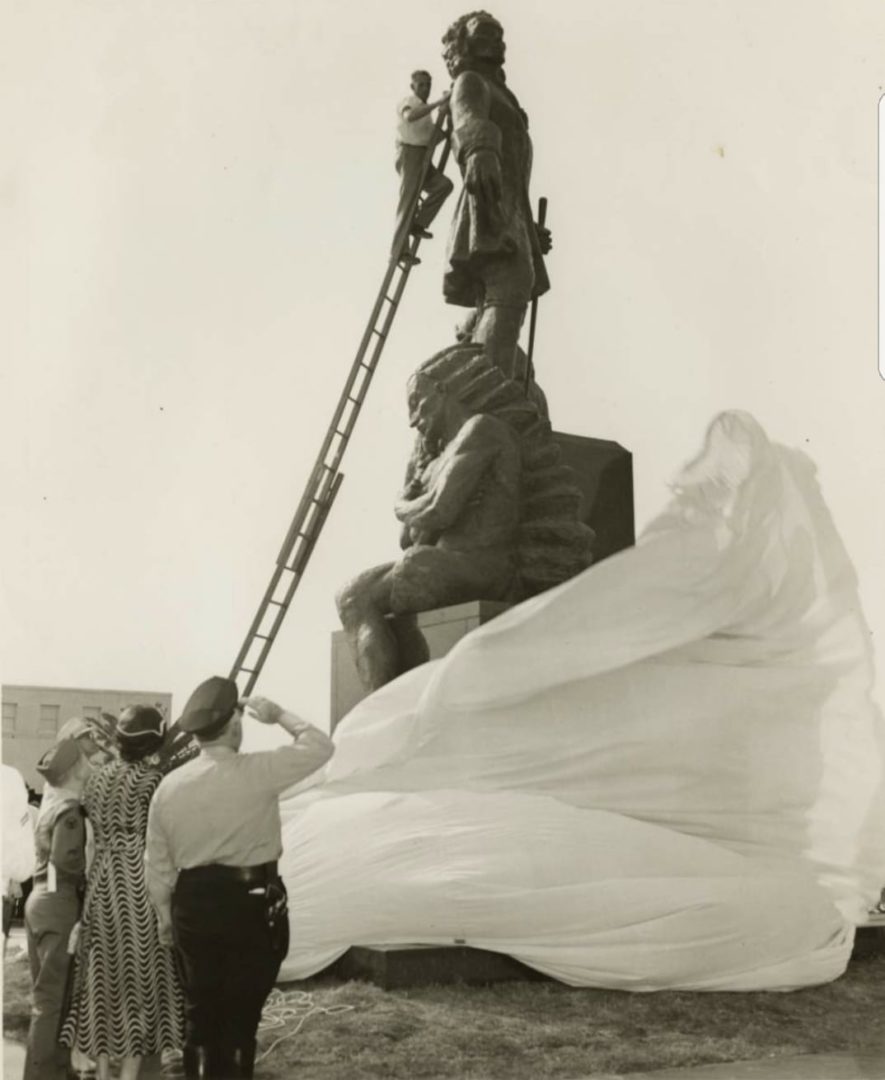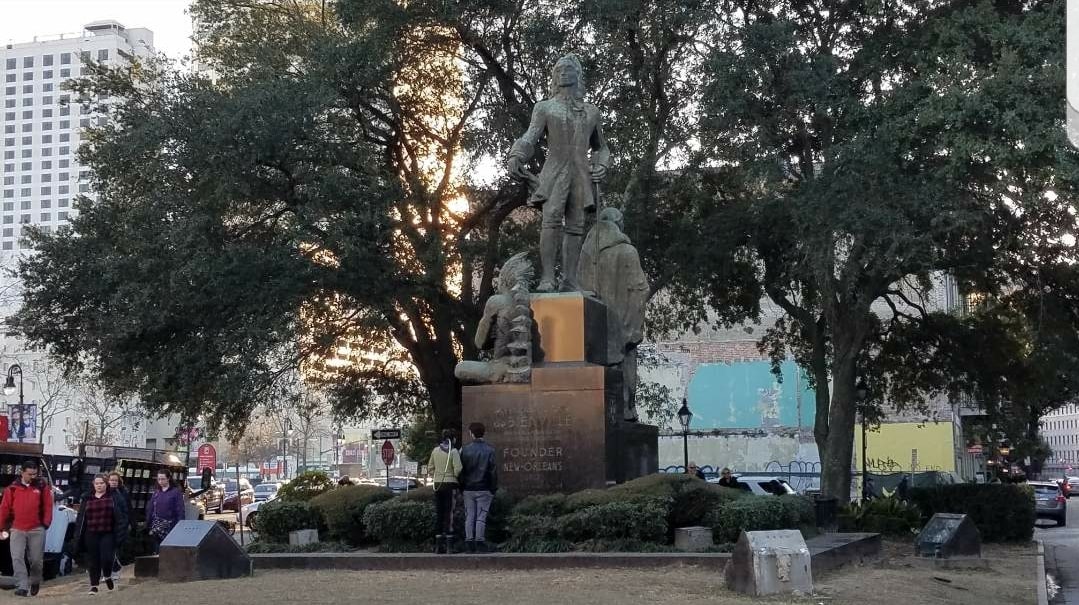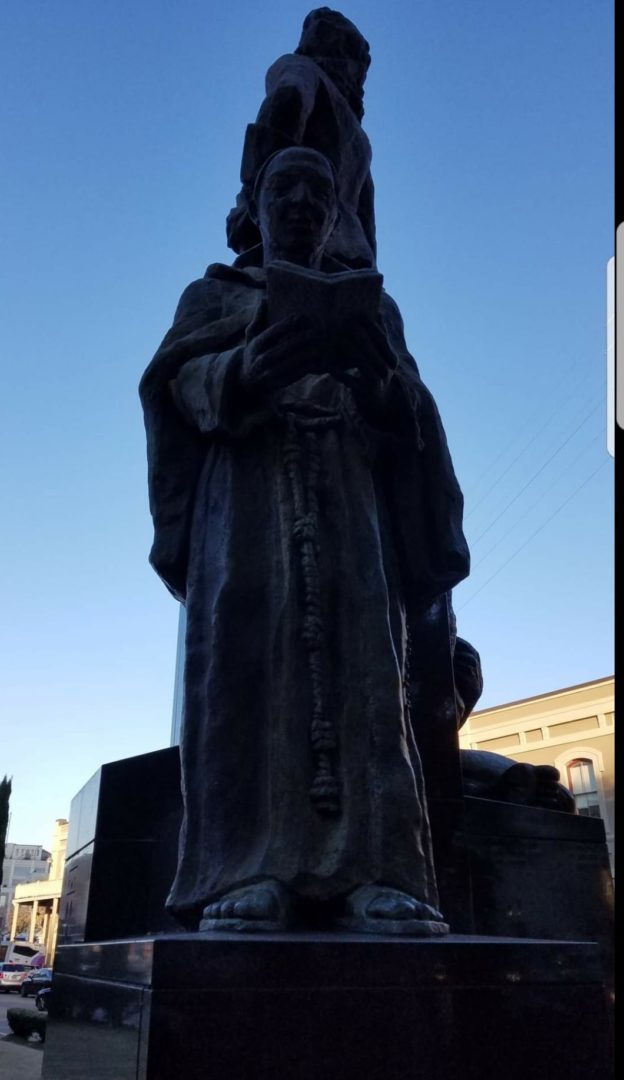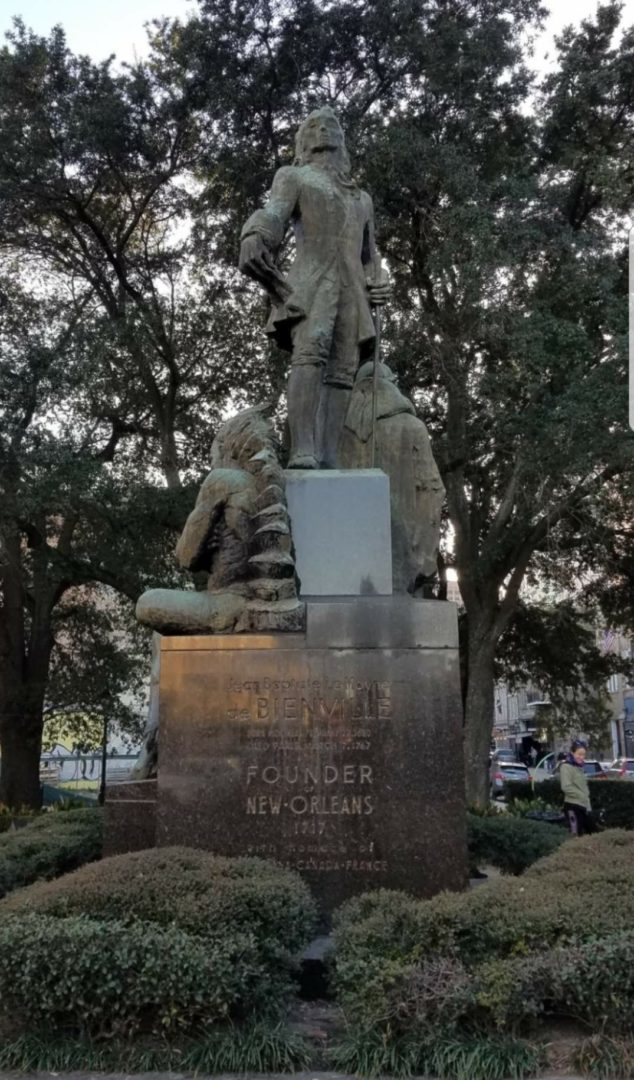I’m bicycling up Decatur Street on the edge of the French Quarter closest to the Mississippi River. I reach the point in the road where Decatur splits with North Peters, forming a small triangle of a park.
On the North Peters side, cars whizz between the H&M and three police vans lined up along the park. On the Decatur side, bubbly jazz music emanates from a tourist T-shirt shop, and the smell of candy apples, cotton candy and chocolate waft from a shop a few doors down.
In the park — between the two streets — is a towering statue, lording over the grassy triangle, and possibly the entirety of the Quarter. I watch a woman with dreadlocks falling out of her green winter beanie, hoola-hooping in the shadow cast by this massive monument.
The monument’s main subject is Jean-Baptiste Le Moyne de Bienville (aka Bienville) and it’s difficult to imagine a figure that has done more to shape our home.
This seemed like a great opportunity to learn more about the man, as well as those who sought to honor him.
The Founder
In 1699, after building a fort in present-day Biloxi, Pierre Le Moyne d’Iberville (aka Iberville) was temporarily recalled for business in France. His younger brother, Bienville — born in Montreal and just 19 years old — was left second-in-command of France’s growing Louisiana colony.
Over the next nearly two decades, the capital of French Louisiana would move between present-day Alabama and Mississippi. Bienville would serve as governor of the colony several times, usually in a temporary capacity while a new governor was chosen and shuttled across the ocean.
Keeping a colony afloat wasn’t easy — and it certainly wasn’t always ethical. Working with the French crown, Bienville fought the British, American Indians and disease. They also had impoverished French women shipped to The New World to… help grow the population.
In 1717, Bienville wrote to John Law and his Company of the Indies — which now controlled the colony. The correspondence notified the Company that he had discovered a crescent bend in the Mississippi River which he “felt was safe from tidal surges and hurricanes and proposed that the new capital of the colony be built there.”
Safe from hurricanes?
He ordered an assistant engineer, Adrien de Pauger, to draw up plans for the new city in 1720, and the blueprint for the eleven-by-seven block rectangle now called the French Quarter, was completed by the following year. Bienville called the new city “La Nouvelle-Orléans” in honor of Philippe II, Duke of Orléans, the prince regent of France. By 1723, during Bienville’s third term as governor, New Orleans had become the capital of all of French Louisiana!
Remembering our hero
Amazingly, it looks like it was almost another 200 years until New Orleans got serious about honoring our founder with a statue. In fact, 1909 is the first time I could find a statue for Bienville mentioned in a New Orleans newspaper as urgency seemed to mount around having something in time for the bicentennial in 1918.
But the years came and went, and there always appeared to be a plan for the monument — but never an actual monument. There was a plan to put it in Jackson Square. Never happened. There was a plan to put it along Bayou St. John. Never happened. There was a plan to put it in City Park — and even a rough itinerary that included a re-enactment of Bienville’s landing along the bayou and putting down the statue’s cornerstone — but, it never happened.
A Times-Picayune article from December 1951 wittily acknowledged the forming of the Bienville Monument Commission: “The city seems to have had more monument commissions than recent additions to stock. A somewhat similar general commission was created during the Works Progress Administration days, but nothing extraordinary came of it.”
The commission chose a sculptor (though this isn’t the first time a sculptor had been chosen to create this statue in the last half-century, but still progress). It was noteworthy that the sculptor — in a field dominated by men — was actually a sculptress.
Angela Gregory — widely referred to as the “doyenne of Louisiana sculpture” — was hired for the job. She was born in New Orleans in 1903 and studied as a sculptress in New Orleans, New York and, finally, in Paris.
Exhibitions of her work have been hosted by venues such as the Metropolitan Museum of Art in New York City, the Salon des Tuileries in Paris, France, and the National Gallery in Washington, D.C. Most of her work, however, can be found in New Orleans and Baton Rouge.
She was commissioned to do an architectural sculpture on the façade of the New Orleans Criminal Courts Building at the intersection of Tulane and Broad streets. (A slightly sexist-sounding headline in the New York Sun about the project read, “Prison Walls Made Less Grim by Girl Sculptor.”)
She created eight bas-relief profiles at the state Capitol for Huey P. Long, depicting men who had shaped the state’s history. And she completed projects in New Orleans that can be seen at McAlister Auditorium at Tulane University, Tulane Medical Center, St. Gabriel’s Catholic Church, and at Gallier Hall — just to name a handful. She even designed camouflage for the Army Corps of Engineers during World War II.
So when she won the job to create the Bienville statue in the early 1950s, Gregory was up for the task.
Obstacles
So what was the holdup?
An October 1952 headline in the New Orleans States declared, “Lack of funds stymies Bienville statue project.”
An article in the Times-Picayune from later that month went into more detail:
“It was estimated that [Gregory’s] monument consisting of three figures — Bienville, a priest, and an Indian — would cost around $77,000, but because it appears that such an amount cannot be raised the commission may have to settle for a single bronze figure of Bienville costing perhaps $25,000 to $30,000 and not as tall as the three 12-foot figures which had been contemplated.”
The funding was supposed to be a combination of contributions from the federal, state, city and French governments, with the remaining amount provided by private donations. Unfortunately, it looked like only France was interested in keeping up their end of the bargain.
In May 1951, Times-Picayune Op-ed regular, Pie Dufor, had another idea as to why New Orleans couldn’t muster the will to complete a statue for our city’s forefather 233 years after he founded the place!
“Perhaps the answer lies in the fact that the Creoles didn’t go in for public statues very much. If you challenge that statement let’s check the important statues around town and you’ll find that none of them is erected to a Creole or a Frenchman.
“It was the Americans who became statue-minded a century ago and, quite naturally, they built statues only to Americans. The most notable of these were Andrew Jackson, Henry Clay and Benjamin Franklin.”
Whatever the reason, the Bienville Monument Commission Chairman, Richard Foster, announced that Gregory’s original three-figure design had been discarded and that a Bienville-only statue would be suggested in its place.
The Eleventh Hour
Within days of Foster’s announcement to scrap the original design, the Archbishop of New Orleans, Joseph F. Rummel, wrote a letter to the Times-Picayune editor calling for the continued pursuit of the three-figure design.
“While concentration on Bienville is commendable,” he wrote on November 3, 1952, “the monument would definitely lose its historic significance by the elimination of the other figures and thus be practically stripped of its importance…”
Rummel also made the case that the reason the commission has had trouble raising the necessary funds was because they hadn’t made an appropriately visible appeal to the public’s civic interest and pride.
And it worked! A little more than a week later, Foster announced his commission had decided to pursue Gregory’s original design.
They set up a fundraising campaign that kicked off in February 1953, and included a plea for donations in the New Orleans Item from Mayor deLesseps S. Morrison.
Pie Dufour wrote another piece on the statue in April 1955 — this time in the New Orleans States — titled, “Bienville, at Last, to Get Statue City Has Owed Him 237 Years.” He wrote how “for a year in New Orleans and two years in France” Gregory completed her three-figure statue.
Dufour concludes his piece, announcing the unveiling will take place on the upcoming Sunday, with French Ambassador to America, Maurice Couve de Murville participating, in front of Union Station.

Finally, April 24, 1955, New Orleans honored its founder with a statue. There were debates as to where the statue should be placed, as well as the date listed as the official founding of the city, but the 4,000-pound monument — rising 26 feet from the ground — was unveiled in front of Union Terminal (opened only a year earlier).
The ceremony included representatives from France and Canada, a marching band, a military presence, and myriad speeches. Morrison celebrated Bienville’s return to the city as “a symbol of New Orleans and of the unconquerable spirit of its people — a spirit that has been tested and tempered in the fires of adversity.”
The Life of a Statue
So when did the statue move to the French Quarter’s Bienville Place? Not for a while.
In 1986, a Times-Picayune article announced the rededication of the statue, which had fallen into disrepair.
“Green corrosion, overgrown bushes and litter had tarnished the bronze monument, showing a collective disrespect for the founder of New Orleans and ruler of the wild Louisiana territory.”
Gregory, at that point 82 years old, was interviewed and said, “When you have spent as many years as I have creating something, it’s rather heartbreaking to see it looking pretty shabby. I was ashamed to look at my monument when I drove by.”
The U.S. Navy directed a group of reservists to clean up the monument for the rededication, under the direction of University of New Orleans history specialist, Steve Gorin, and Gregory’s heart was mended.
Then, in 1993, it was announced Bienville’s statue would be moved. The French Quarter home of a former gas station — where Decatur, North Peters and Conti all meet — was being converted into a park. Plans for the space called for a monument, and it was decided Bienville would be perfect.
The reasons? It cost a lot more to acquire the land than the City thought, so there wasn’t much money available to build a brand new monument. Also, Bienville statue supporters were pleased that more people would see it in the French Quarter. Finally, possible construction around a new streetcar line to Union Terminal meant this would be the perfect time to move it.
As is often the case, it took a few more years than originally thought. But, in February 1997, Bienville arrived at his new home.
A prominent home for a prominent character
A car blasts its horn at pedestrians scurrying across North Peters. I walk around the statue to admire the three figures represented. I begin with the monk — poring over his Bible — meant to symbolize the connection between the early French explorers and Bienville. This monk originally came to the area with the explorer, de la Salle, and then was ordered to return with Bienville by King Louis XIV. When he reached the Mississippi River — from the Gulf of Mexico — with Bienville, he is reported to have said, “This is the stream.
Next is the muscular American Indian, thoughtfully admiring his pipe. Gregory said his inclusion was important as the first human Bienville met when landing here. We also know the city of New Orleans was chosen in large part because of American Indian knowledge of how Lake Pontchartrain and Lake Borgne connect to the Gulf of Mexico (and, as a result, the rest of the world).
And, finally, there is Bienville. I consider his face. He was made to look fearless. But, with the life he led, I don’t see how that’s possible. Born in a small town that would, decades later, become Montreal. Leaving home at 17 years old to compete against the British, the strongest military in the world, for a settlement in a land full of danger. And then carrying the full weight of that burgeoning colony on his shoulders.
How could he be fearless?
Bienville left New Orleans for the final time in 1743. He lived the rest of his life in France, but — even while across the Atlantic — he fought for New Orleans, trying unsuccessfully to discourage the French from ceding the colony to Spain.
He may not have succeeded in that final mission, but — while standing at the foot of Gregory’s statue — Bienville’s success is all around us. The pair of kids tap dancing on Decatur Street to the delight of tourists passing by. The brass band leading a wedding’s second line somewhere through the Quarter. An entire city along the river.
None of this — or anything else around it — would be possible if it wasn’t for Jean-Baptiste Le Moyne de Bienville. It took a while, but this statue is an appropriate commemoration to his efforts.
Writer Matt Haines lives in New Orleans. Follow him at matthaineswrites.com, and on Facebook, Twitter and Instagram.












